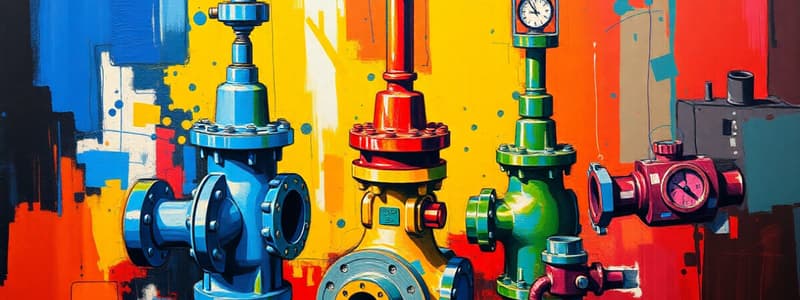Podcast
Questions and Answers
What is the primary function of a control valve in a closed control loop?
What is the primary function of a control valve in a closed control loop?
- To control flow rate (correct)
- To measure pressure
- To regulate temperature
- To maintain valve position
What component of a control valve determines its failure position?
What component of a control valve determines its failure position?
- Actuator
- Transducer
- Handwheel
- Spring (correct)
Under what circumstances would hydraulic piston type actuators be utilized?
Under what circumstances would hydraulic piston type actuators be utilized?
- Standard operational conditions
- Higher pressure requirements (correct)
- Low pressure situations
- For precision control
What does the valve positioner indicate?
What does the valve positioner indicate?
What type of control valve design is known to facilitate greater flows?
What type of control valve design is known to facilitate greater flows?
What does an instrument air regulator do?
What does an instrument air regulator do?
What type of regulator controls pressure downstream?
What type of regulator controls pressure downstream?
Which statement about a 3 way valve is correct?
Which statement about a 3 way valve is correct?
Flashcards
Control Valve Failure Mode
Control Valve Failure Mode
Control valves are designed to either open, close or remain in a stationary position when power is lost.
Hydraulic Actuators in Valves
Hydraulic Actuators in Valves
Hydraulic piston type actuators are needed for control valves requiring higher pressures.
Valve Positioner Function
Valve Positioner Function
The valve positioner converts an electrical signal (mA) to a pneumatic signal, adjusting the valve's position accordingly
Valve Positioner Gauges
Valve Positioner Gauges
Signup and view all the flashcards
Handwheel Override
Handwheel Override
Signup and view all the flashcards
3-Way Valve Function
3-Way Valve Function
Signup and view all the flashcards
Control Valve Design for Flow
Control Valve Design for Flow
Signup and view all the flashcards
Instrument Air Regulator Purpose
Instrument Air Regulator Purpose
Signup and view all the flashcards
Study Notes
Control Valves and Regulators
- Final control element: The most common final control element in a closed control loop is a valve.
- Failure position of control valves: Control valves are generally designed to fail in an open, closed, or fail-in-place/stationary position. The failure position is determined by the spring.
- Hydraulic actuators: Hydraulic piston type actuators are necessary for higher pressures in control valves.
- Transducer: The part of a control valve that converts a mA signal to a pneumatic signal is called a transducer.
- Valve positioner: The valve positioner is equipped with three gauges: instrument (in) and system air.
- Handwheel override: A handwheel can override the positioner (True).
- 3-way valve: A 3-way valve is used for mixing or diverting flow, allowing one flow stream to go in two directions (True).
- Valve flow design: A butterfly valve design provides greater flow.
- Instrument air regulator purpose: The instrument air regulator controls air pressure by reducing it.
- Spring function: The spring in a control valve provides energy to open or close the valve. Loss of power may cause the valve to close.
- Back pressure regulator vs pressure reducing regulator: A back pressure regulator controls pressure upstream, while a pressure reducing regulator controls pressure downstream.
Studying That Suits You
Use AI to generate personalized quizzes and flashcards to suit your learning preferences.



